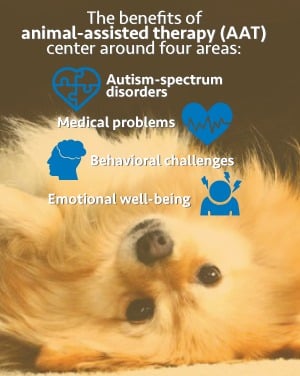Animals tend to evoke an emotional response in us. If you dislike the critters, that’s one thing, but bring a dog into the office or run into the resident cat at the corner pet store, and most people are reduced to mush.
There’s something about a look at a black lab or tabby that can dissolve barriers. That’s where animal-assisted therapy (AAT) can shine in therapeutic settings.
It seems like it’d be a new phenomenon — the term definitely is — but animals have been used for help with healing for centuries. Ancient Greeks used horses to help raise the spirits of the ill. In medieval Belgium, people and animals sometimes rehabilitated together. Even Dr. Sigmund Freud found that having his pet dog present for therapy sessions was calming to many of his patients.
 Recent headlines have been full of stories of emotional support animals being barred on planes, which perhaps casts a dark shadow on some critters’ perceived psychological health benefits.
Recent headlines have been full of stories of emotional support animals being barred on planes, which perhaps casts a dark shadow on some critters’ perceived psychological health benefits.
One flier’s support peacock is another person’s feather-and-bird droppings nuisance, after all.
But the Human-Animal Bond is fairly well established — that relationship between animals and people which benefits both parties emotionally, psychologically and physically. (AAT formally began in the early 1960s after Dr. Boris Levinson published his findings on how pets helped both his child and adult psychotherapy patients.)
That can be seen in the fact that nearly 85 million Americans, or 68 percent of U.S. households own a pet, according to the American Pet Products Association (APPA) National Pet Owners Survey. Of those polled, 82 found it relaxing to interact with a pet, and 81 percent believe animals were good for their health.
Animals are judgment free, with no preconceived notions, and their unconditional love boosts confidence and sparks interaction.
The benefits of animal-assisted therapy (AAT) center around four areas:
- Autism-spectrum disorders
- Medical problems
- Behavioral challenges
- Emotional well-being
There is a difference between therapy and service dogs (dogs outnumber all other service, therapy and helper animals), even though many use the terms interchangeably. According to the Americans with Disabilities Act, service dogs are trained to perform tasks for people with handicaps — like seeing-eye dogs or pulling someone’s wheelchair.
Service animals are working animals. They are not pets. Therapy animals, on the other hand, are not supported under the ADA. These animals are trained, but not to the extent service dogs are. They tend to visit nursing homes, hospitals or schools to soothe stressed people.
Can Animals Help in Addiction Treatment?
It’s been well documented that animals can help in a number of therapeutic settings.
Patients with psychiatric disorders have been found to experience reduced anxiety in AAT sessions. Pain and pain-related symptoms are lessened when therapy dogs visit patients. Companion dogs have proven helpful in reducing depression, anxiety and loneliness in military veterans with post-traumatic stress disorder.
When asking, can pets help prevent addiction, however, answering that question is tricky. There is no clear-cut cause for addiction, just like there is no one simple approach to treating it. A number of factors influence the likelihood of addiction, including biology (genetics, mental disorders, ethnicity, gender); environment (peer pressure, parental support); and development (earlier drug use leads to a greater likelihood of addiction).
As for treating addiction, a number of therapies have proven effective, including:
- Behavioral therapies and/or counseling
- Medically-assisted treatment
- Addressing co-occuring mental health disorders like depression
- Aftercare plans to prevent relapse
Each patient and each patient’s case is unique, so factors like mental health, personal history, safe detoxification, follow-up care and other elements should all be considered when molding treatment plans.
Animal-Assisted Therapy
 AAT can be done in both individual and group settings. Typically patients regularly interact with animals, sometimes petting them or just sitting with them.
AAT can be done in both individual and group settings. Typically patients regularly interact with animals, sometimes petting them or just sitting with them.
One happy side effect of engaging with dogs or cats and other beasties is that oxytocin levels — a hormone that facilitates bonding — tend to rise after some time in their presence. The evidence that the presence of animals in a therapeutic setting can truly help the healing process from both physical and mental maladies isn’t a home-run. Questions linger about exactly how effective it is, but it does seem like they can help slash anxiety and fear, and improve daily life.
What is Animal-Assisted Addiction Treatment?
Not just any animal can serve in a therapeutic capacity. A veterinarian behaviorist or animal behaviorist typically will examine candidates to ensure the critter’s health, behavior and temperament are right for the job. Training of the animal is involved, as well. Conversely, the animal’s welfare should also be checked, not just for physical health but also that it’s getting treated properly.
Finding a therapy animal can be a bit tricky sometimes. A few organizations like Pet Partners, Therapy Dogs International and the Good Dog Foundation all promote the healing link that can form between humans and animals, typically by training animals for therapy and bringing them into healthcare and school settings.
Dog, Cat, or?

Most people probably think of dogs first when the topic of therapy animals comes up. As for which animals usually participate in recovery for substance use disorder (or any other mental health disorder), it’s true that dogs do take the lead. Canines have been bred to serve alongside humans, so their temperament and that they can be trained to be obedient make them ideal therapy animals. An organization like Pet Partners, 94 percent of its helper pets are dogs. They also have:
- Cats
- Equines (miniature horses, ponies, donkeys)
- Rabbits, guinea pigs, domestic rats
- Birds (primarily parrots)
- Miniature pigs
- Alpacas
Equine therapy can help in a number of ways, primarily as a form of experiential therapy.
One not need ride or practice horsemanship for therapeutic purposes, though riding a horse can help a patient restore some strength and balance. Working with horses can help with cases of PTSD, anxiety and substance use disorder as well.
Animal-assisted therapy makes sense for the person who has an affinity with animals, or who is receptive to interacting with our four-legged (and sometimes two-legged) friends. Animals can help improve the day-to-day life of people with substance use disorders. A cat or dog isn’t a cure for addiction, but a pet may help keep someone on track and take better care of themselves simply because the animal will need someone to watch out for it.
When trying to find out where to get animal-assisted therapy for addiction, it’s best to consult with both the addiction treatment provider, and to research animal therapy organizations. That way one can find a suitable and science-backed recovery program and individualize it with complementary animal-accompanied therapies.
(It should be noted that using dogs for addiction treatment — or any other animal, for that matter — isn’t likely to remedy the substance use disorder. Rather, animal-assisted therapy can be a fine complement to the treatment process.)
Sources
Medical disclaimer:
Sunshine Behavioral Health strives to help people who are facing substance abuse, addiction, mental health disorders, or a combination of these conditions. It does this by providing compassionate care and evidence-based content that addresses health, treatment, and recovery.
Licensed medical professionals review material we publish on our site. The material is not a substitute for qualified medical diagnoses, treatment, or advice. It should not be used to replace the suggestions of your personal physician or other health care professionals.







